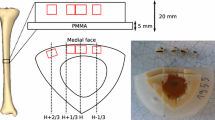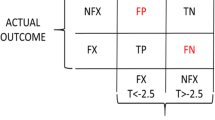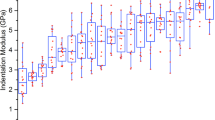Summary
The square of ultrasound transmission velocity in a material is related to the modulus of elasticity, which is known to be an indicator of stability in bone. The aim of our study was to use ultrasound transmission velocity to obtain information about the material properties of bone tissue, keeping other factors possibly influencing ultrasound transmission as constant as possible. Apparent phalangeal ultrasound transmission velocity (APU) measured in 54 isolated, fresh pig phalanges was shown to be independent of bone mineral density (BMD) measured by SPA. Fastest sound transmission led exclusively through cortical bone so that intertrabecular connectivity in spongious bone could not influence the result. In humans APU was measured in the mediolateral direction at the midphalanx of the middle finger. In 53 healthy subjects (15–81 years old; 27 women, 26 men), there was a decrease of APU with age (r=−0.30, p<0.05). Further, when comparing the results of both hands intraindividually almost identical values indicated constant intraindividual architecture of bone at this location. There was no evidence for a relation of APU to physical load comparing dominant and nondominant hand and relating the results to subjectively estimated physical load. In a second group of 43 perimenopausal women (47–60 years old), APU, which again decreased with age (r=−0.33, p<0.05), was found not be correlated to BMD measured by SPA at the distal forearm (cortical bone). In a third group of 40 women (17–78 years old), APU again decreased with age (r=−0.60, p<0.001) and was not correlated to BMD measured by SPA at the midphalanx of the middle finger, i.e. the same measuring location as APU. We conclude that this method provides information about the modulus of elasticity of bone with negligible influence of bone mineral density. Our results indicate that there is a deterioration of bone material quality with age independent of decreasing bone mineral density.
Similar content being viewed by others
References
Gotfredsen, A., Nilas, L., Pödenphant, J., Hadberg, A., Christiansen, C. Regional bone mineral in healthy and osteoporotic women: a cross-sectional study. Scand J Clin Lab Invest 1989, 149, 739–749.
Burr, D.B., Martin, R.B. The effects of composition, structure and age on the torsional properties of the human radius. J Biomechanics 1983, 6, 603–608.
Riggs, B.L., Hodgson, S.F., O'Fallon, W.M., Chao, E.Y.S., Wahner, H.W., Muhs, J.M., Cedel, S.L., Melton, III, L.J. Effect of fluoride treatment on the fracture rate in postmenopausal women with osteoporosis. N Engl J Med 1990, 322, 802–809.
Kleerekoper, M., Peterson, E.L., Nelson, D.A., Phillips, E., Schork, M.A., Tilley, B.C., Parfitt, A.M. A randomized trial of sodium fluoride as a treatment for postmenopausal osteoporosis. Osteoporosis Int 1991, 1, 155–161.
Kübler, A., Schulz, G., Schmidtmann, I., Cordes, U., Beyer, J., Krause, U. Measurement of bone mineral density at the distal forearm of healthy men and women using single-photon absorptiometry. Nuc Compact 1991, 22, 47–50.
Bätge, B., Diebold, J., Bodo, M., Fehm, H.L., Müller, P.K. Evidence for bone matrix alterations in osteoporosis. In: Current Research in Osteoporosis and Bone Mineral Measurement II: 1992: Ed.: E.F.J. Ring, British Institute of Radiology, London, 1992, 45–46.
Gobrecht, H. Bergmann-Schäfer Lehrbuch der Experimentalphysik. Band I Mechanik Akustik Wärme. Berlin, New York, Walter de Gruyter, 1974, 240–248.
Abenschein, W., Hyatt, G.W. Ultrasonics and selected properties of bone. Clin Orthop 1970, 69, 294–301.
Sedlin, E.D., Hirsch, C. Factors affecting the determination of the physical properties of femoral cortical bone. Acta Orthop Scandinav 1966, 37, 29–48.
Martin, R.B., Burr, D.B. Non-invasive measurement of long bone cross-sectional moment of inertia by photon absorptimetry. J. Biomechanics 1984, 17, 195–201.
McCabe, F., Zhou, L.-J., Steele, C.R., Marcus, R. Non-invasive assessment of ulnar bending stiffness in women. J Bone Miner Res 1991, 6, 53–59.
Myburgh, K.H., Zhou, L.-J., Steele, C.R., Arnaud, S., Marcus, R. In vivo assessment of forearm bone mass and ulnar bending stiffness in healthy men. J Bone Miner Res 1992, 7, 1345–1350.
Greenfield, M.A., Craven, J.D., Huddlestone, A., Kehrer, M.L., Wishko, D., Stern, R. Measurement of the velocity of ultrasound in human cortical bone in vivo. Radiology 1981, 138, 701–710.
Ashman, R.B., Cowin, S.C., van Buskink, W.C., Rice, J.C. A continuous wave technique for the measurement of the elastic properties of cortical bone. J Biomechanics 1984, 17, 349–361.
Jeffcott, L.B., McCartney, R.N. Ultrasound as a tool for assessment of bone quality in the horse. Veterinary Record 1985, 116, 337–342.
Brandenburger, G.H. Ultrasonic Bone Assessment. Framingham, Osteo-Technology, Inc., 1989.
Hosie, C.J., Smith, D.A., Deacon, A.D., Langton, C.M. Comparison of broadband ultrasonic attenuation of the os calcis and quantitative computed tomography of the distal radius. Clin Phys Physiol Meas 1987, 8, 303–308.
Baran, D.T., Kelly, A.M., Karellas, A., Gionet, M., Price, M., Leahey, D., Steuterman, S., McSherry, B., Roche, J. Ultrasound attenuation of the os calcis in women with osteoporosis and hip fractures. Calcif Tissue Int 1988, 43, 138–142.
McKelvie, M.L., Fordham, J., Clifford, C., Palmer, S.B. In vitro comparison of quantitative computed tomography and broadband ultrasonic attenuation of trabecular bone. Bone 1989, 10, 101–104.
McCloskey, E.V., Murray, S.A., Miller, C., Charlesworth, D., Tindale, W., O'Doherty, D.P., Bickerstaff, D.R., Hamdy, N.A.T., Kanis, J.A. Broadband ultrasound attenuation in the os calcis: relationship to bone mineral at other skeletal sites. Clin Science 1990, 78, 227–233.
McCloskey, E.V., Murray, S.A., Charlesworth, D., Miller, C., Fordham, J., Clifford, K., Atkins, R., Kanis, J.A. Assessment of broadband ultrasound attenuation in the calcis in vitro. Clin Science 1990, 78, 221–225.
Resch, H., Pietschmann, P., Bernecker, P., Krexner, E., Willvonseder, R. Broadband ultrasound attenuation: a new diagnostic method in osteoporosis. AJR 1990, 155, 825–828.
Baran, D.T., McCarthy, C.K., Leahey, D., Lew, R. Broadband ultrasound attenuation of the calcaneus predicts lumbar and femoral neck density in Caucasian women: a preliminary study. Osteoporosis Int 1991, 1, 110–113.
Rossman, P., Zagzebski, J., Mesina, C., Sorenson, J., Mazess, R. Comparison of speed of sound and ultrasound attenuation in the os calcis to bone density of the radius, femur and lumbar spine. Clin Phys Physiol Meas 1989, 10, 353–360.
Rubin, C.T., Pratt Jr., G.W., Porter, A.L., Lanyon, L.E., Poss, R. Ultrasonic measurement of immobilization-induced osteopenia: an experimental study in sheep. Calcif Tissue Int 1988, 42, 309–312.
Heaney, R.P., Avioli, L.V., Chesnut III, C.H., Lappe, J., Recker, R.R., Brandenburger, G.H. Osteoporotic bone fragility — detection by ultrasound transmission velocity. JAMA 1989, 261, 2986–2990.
Genant, H.K., Vogler, J.B., Block, J.E. Radiology of osteoporosis. In: Osteoporosis: Etiology, Diagnosis and Management. Eds.: B.L. Riggs, L.J. Melton III, New York, Raven Press, 1988, 181–220.
Kann, P., Schulz, U., Nink, M., Pfützner, A., Schrezenmeir, J., Beyer, J. Architecture in cortical bone and ultrasound transmission velocity. Clin Rheumatol 1993, 12, 364–367.
Ashmann, R.B., Rho, J.Y., Turner, C.H. Anatomical variation of orthotropic elastic moduli of the proximal human tibia. J Biomechanics 1989, 22, 895–900.
Kann, P., Gaul, P., Unger, M., Wandel, E., Renschin, G., Beyer, J. Apparente Phalangeale Ultraschall-Transmissions-Geschwindigkeit und periphere Knochendichte bei Hämodialyse-assoziierter Osteopathie und manifester Osteoporose. In: CRHUKS-OPO '93. Eds.: C., Reiners, F. Raue, Sektion Calciumregulierende Hormone und Knochenstoffwechsel der Deutschen Gesellschaft für Endokrinologie, Essen, 1993, 17.
Author information
Authors and Affiliations
Rights and permissions
About this article
Cite this article
Kann, P., Schulz, U., Klaus, D. et al. In-vivo investigation of material quality of bone tissue by measuring apparent phalangeal ultrasound transmission velocity. Clin Rheumatol 14, 26–34 (1995). https://doi.org/10.1007/BF02208081
Received:
Revised:
Accepted:
Issue Date:
DOI: https://doi.org/10.1007/BF02208081




